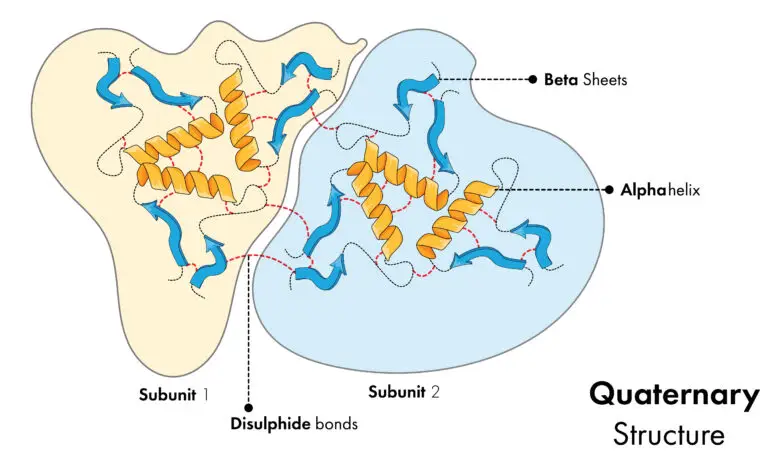Quaternary Structure

Table of Contents
What is a Quaternary Structure?
Quaternary structure is the highest level of protein structure, describing the arrangement and interactions of multiple protein subunits (polypeptide chains) that come together to form a functional, biologically active complex.
Proteins with quaternary structures consist of two or more individual polypeptide chains, known as subunits, which may be identical or different. These subunits are held together by various interactions, such as hydrogen bonds, disulfide bonds, and hydrophobic interactions.
Overview of Quaternary Structure
Multiple Subunits
Proteins with quaternary structure are composed of two or more individual polypeptide chains, each acting as a subunit. These subunits may have distinct functions or contribute to the overall function of the protein complex.
Stabilizing Interactions
The interactions stabilizing the quaternary structure can include hydrogen bonds, disulfide bonds, hydrophobic interactions, and electrostatic interactions between amino acid residues of different subunits.
Functional Consequences
The quaternary structure is essential for the biological activity of certain proteins. The arrangement of subunits allows the protein complex to carry out specific functions, such as catalyzing biochemical reactions, transporting molecules, or providing structural support.
Assembly and Dissociation
The quaternary structure of a protein complex is not static. Many proteins with quaternary structures can undergo assembly and dissociation in response to changes in environmental conditions or cellular signals. The reversible nature of these interactions allows for flexibility in protein function.
Determination of Quaternary Structure
Techniques such as X-ray crystallography, nuclear magnetic resonance (NMR) spectroscopy, and cryo-electron microscopy are used to determine the three-dimensional structures of proteins, including their quaternary arrangements.
Examples of Proteins with Quaternary Structure
Hemoglobin: Hemoglobin is a well-known example of a protein with a quaternary structure. It has four subunits – two alpha globin and two beta globin chains. Hemoglobin is responsible for transporting oxygen in red blood cells.
DNA Polymerase: Some DNA polymerase enzymes involved in DNA replication have a quaternary structure. They are composed of multiple subunits that work together during the synthesis of DNA.
Antibodies: Immunoglobulins, or antibodies, often have a quaternary structure. They consist of two heavy and light chains, contributing to their specificity in recognizing and binding to antigens.
Related Links
Anibodies
Overview of DNA
Proteins
RNA